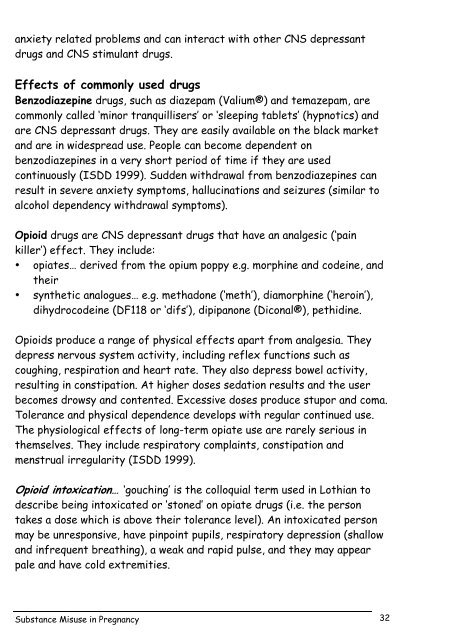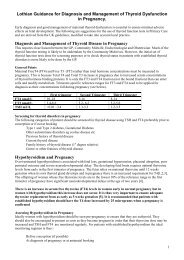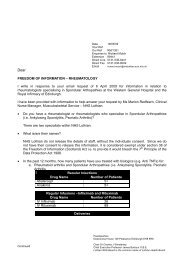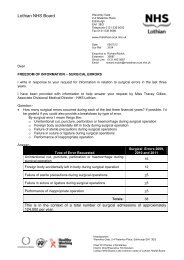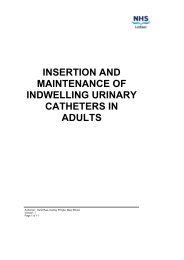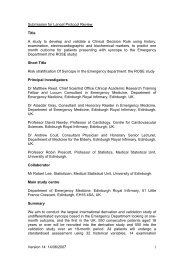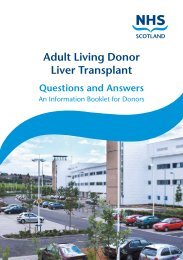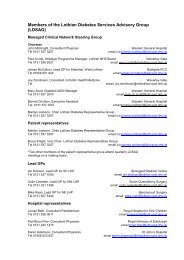Substance Misuse in Pregnancy - NHS Lothian
Substance Misuse in Pregnancy - NHS Lothian
Substance Misuse in Pregnancy - NHS Lothian
You also want an ePaper? Increase the reach of your titles
YUMPU automatically turns print PDFs into web optimized ePapers that Google loves.
anxiety related problems and can <strong>in</strong>teract with other CNS depressant<br />
drugs and CNS stimulant drugs.<br />
Effects of commonly used drugs<br />
Benzodiazep<strong>in</strong>e drugs, such as diazepam (Valium®) and temazepam, are<br />
commonly called ‘m<strong>in</strong>or tranquillisers’ or ‘sleep<strong>in</strong>g tablets’ (hypnotics) and<br />
are CNS depressant drugs. They are easily available on the black market<br />
and are <strong>in</strong> widespread use. People can become dependent on<br />
benzodiazep<strong>in</strong>es <strong>in</strong> a very short period of time if they are used<br />
cont<strong>in</strong>uously (ISDD 1999). Sudden withdrawal from benzodiazep<strong>in</strong>es can<br />
result <strong>in</strong> severe anxiety symptoms, halluc<strong>in</strong>ations and seizures (similar to<br />
alcohol dependency withdrawal symptoms).<br />
Opioid drugs are CNS depressant drugs that have an analgesic (‘pa<strong>in</strong><br />
killer’) effect. They <strong>in</strong>clude:<br />
• opiates… derived from the opium poppy e.g. morph<strong>in</strong>e and code<strong>in</strong>e, and<br />
their<br />
• synthetic analogues… e.g. methadone (‘meth’), diamorph<strong>in</strong>e (‘hero<strong>in</strong>’),<br />
dihydrocode<strong>in</strong>e (DF118 or ‘difs’), dipipanone (Diconal®), pethid<strong>in</strong>e.<br />
Opioids produce a range of physical effects apart from analgesia. They<br />
depress nervous system activity, <strong>in</strong>clud<strong>in</strong>g reflex functions such as<br />
cough<strong>in</strong>g, respiration and heart rate. They also depress bowel activity,<br />
result<strong>in</strong>g <strong>in</strong> constipation. At higher doses sedation results and the user<br />
becomes drowsy and contented. Excessive doses produce stupor and coma.<br />
Tolerance and physical dependence develops with regular cont<strong>in</strong>ued use.<br />
The physiological effects of long-term opiate use are rarely serious <strong>in</strong><br />
themselves. They <strong>in</strong>clude respiratory compla<strong>in</strong>ts, constipation and<br />
menstrual irregularity (ISDD 1999).<br />
Opioid <strong>in</strong>toxication… ‘gouch<strong>in</strong>g’ is the colloquial term used <strong>in</strong> <strong>Lothian</strong> to<br />
describe be<strong>in</strong>g <strong>in</strong>toxicated or ‘stoned’ on opiate drugs (i.e. the person<br />
takes a dose which is above their tolerance level). An <strong>in</strong>toxicated person<br />
may be unresponsive, have p<strong>in</strong>po<strong>in</strong>t pupils, respiratory depression (shallow<br />
and <strong>in</strong>frequent breath<strong>in</strong>g), a weak and rapid pulse, and they may appear<br />
pale and have cold extremities.<br />
<strong>Substance</strong> <strong>Misuse</strong> <strong>in</strong> <strong>Pregnancy</strong><br />
32


